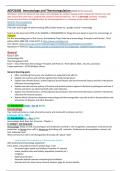Summary
ADP20306 Immunology & Thermoregulation Summary
- Course
- Institution
This is a English summary of both parts of the course ADP-20306: Immunology and Thermoregulation, given in period 2 at the WUR. This is a thorough summary, including all lecture notes, practicals and reader summary and questions. Also the imporant parts used in practice exams of immunology are hi...
[Show more]



